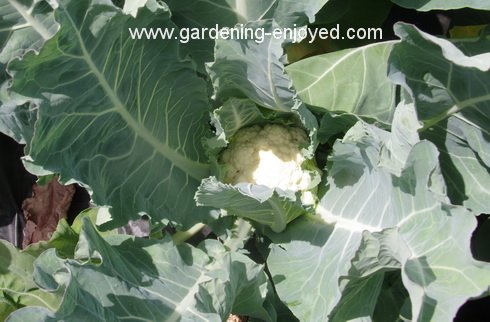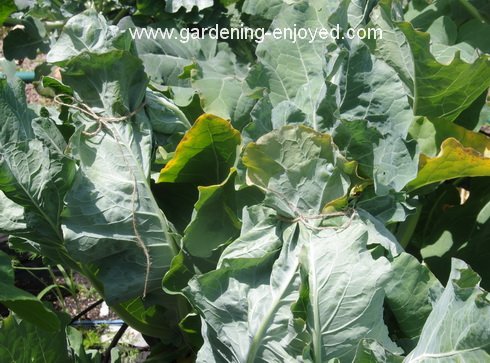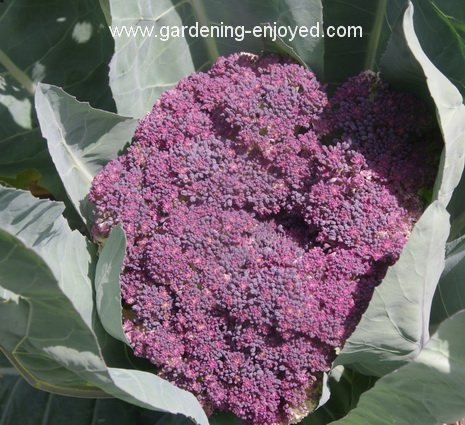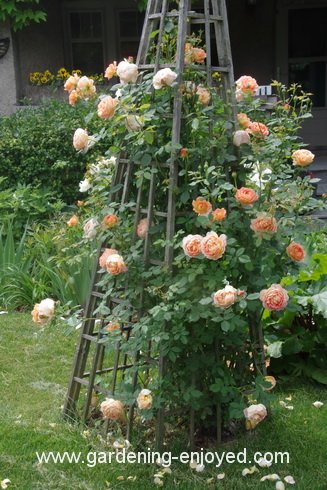
Sometimes I’m a bit of a slow learner. After several years of trying to get Clematis to climb some of my trellis, with limited success, I finally realized that they didn’t like the rather thick arms of those trellis. This year I stapled chicken wire to some of those thick trellis and this picture is the result. They are climbing to new heights and I’m having to do a lot less weaving and coaxing. This dark red one on the corner of the deck has become a real star and a few of the others are responding as well. Old dog, new tricks!

That strange beast we call sprouting Cauliflower has finished its season and the regular Cauliflower has started to emerge deep down among its large leaves. Cauliflower looks its best and tastes best when it is as white as possible. To achieve that we must try to keep the sunlight from reaching the curds. Tying those big leaves together to stop the sun from reaching those white heads is a step known as blanching. It takes a few minutes to pull the leaves together and wrap a bit of string around and the result is a lovely very white head of Cauliflower.


These two pots of Begonia boliviensis look quite different and they are. It’s my observation that they are quite different, partly because they are different varieties but more so because the smaller one on the right is from seeds I collected last year and the bigger one on the left is from purchased seed this year. These Begonias are obviously hybrids and apparently do not come true from collected seed but rather look like some of their parents. They are equally lovely but the purchased seed seems to grow much more vigorously. The problem is the collected seed is free but the purchased seed is about $1 per seed and I’m notoriously frugal. That purchased seed is also pelleted which makes the very tiny Begonia seed much easier to handle. I’m never had any problem getting the collected seed to germinate but you do wind up with hundreds of very tiny seedlings to care for and eventually transplant. Gardening is always an interesting experiment.

Now this is a Cauliflower that we don’t want to blanch. The rich purple colour develops naturally and is a delight to see in the garden. It is delicious raw on a vegetable and dip tray. Its other benefit is its ability to retain its colour when it is cooked, either roasted or lightly steamed it brings its delightful colour to the dinner plate. It has a bit heartier flavour and a few more anti-oxidants that its white cousin. It looks a bit like a Broccoli but apparently it is a Cauliflower although that difference is minimal. It’s a delight to grow whatever we want to call it.

It has been a wonderful year for most of my perennial plants, whether herbaceous or woody. Right now the front yard is filled with colour from a variety of those plants. The Clematis aromatica on the right with its multitude of little purple and white flowers sort of overshadows its more demure double flowered cousin to its left and then we come to the Lady of Shallott a superb David Austin rose that has been very hardy in my garden and blooms all summer. On the far left is my Rose tree. This is one of my better experiments. I always wanted a Rose tree but the commercially available ones are usually made by grafting a fancy rose onto a shrub rose upright and they are rarely hardy. I purchased one of the Canadian explorer Roses, very hardy, and spent a few years pruning and training it to a single stem and then let that stem branch when it
reached about 1.5M (5 ft). After a few years I had several stems to that height and the result is this huge display of red Roses in a small tree form. It’s always fun to experiment to see if I can get Mother Nature to produce what I want and occasionally I actually succeed. The following pictures are those two Roses up a little closer.


We are regularly traveling to speaking engagements and are always happy to add more to the schedule. If your club or group would like to have me present one of my informative and entertaining talks just fill out the speaker request form and we can find a suitable date and topic.
If you have any gardening questions just “reply” to this newsletter and I will attempt to answer them.
Peter Asks? I have 2 or 3 brown leaves on my garlic. Can I harvest a few of these plants already?
Ken Answers!It seems strange that you have those brown leaves this early unless you live a lot farther south than me. Have they developed long complete scapes yet? I would wait until that happens and then maybe dig one to see what has developed.
Penny Asks? Do you have a favourite among all those
Iris?
Ken Answers!My favourite Iris seems to be the one that flowered for the first time on the day that people ask me that question:-)
Lynn Asks?I wonder if the allium is Mt. Everest? I have it and am wondering if it's fairly well behaved? (Non-invasive)
Ken Answers!Yes, I do believe it is Mt Everest and it is fairly well behaved in that front garden but it is running amok in my back Hosta bed. I now deadhead them before they have a chance to disburse any seeds.
Diana Asks? I have a question about the lily beetle. Can they be eliminated? I have had problems with them for the past three years. I have hand picked them, sprayed them with a neem oil mix, poured the mix in the soil and they keep returning. Help!!!
Ken Answers!If you can find an effective and simple method for controlling them you could become rich. I hand pick them, actually using a pair of needle nosed pliers, and then watch
the underside of the leaves for the egg masses, little strips of orange, and easily wipe those off. Hand picking the larva is a less pleasant job but I still work at it, as the are the most destructive phase. You have to decide if Lilies are worth the effort. Mine are so I keep at it. The harder you work at it the smaller the population in the following years but "eliminate" is not a word that would ever describe my success.
|








